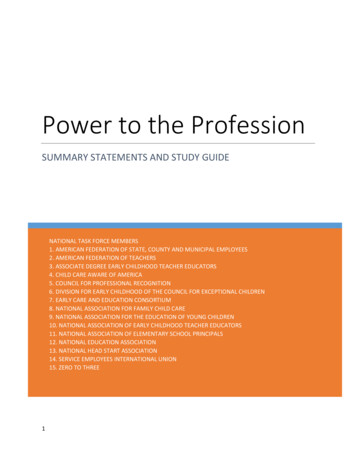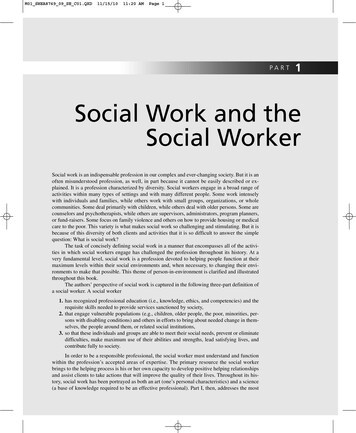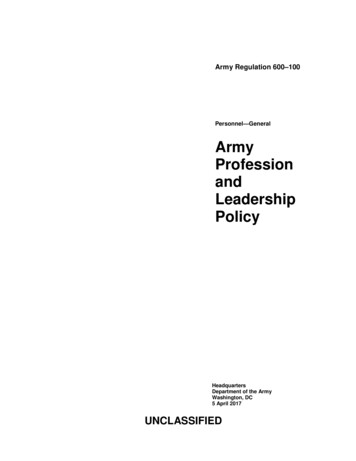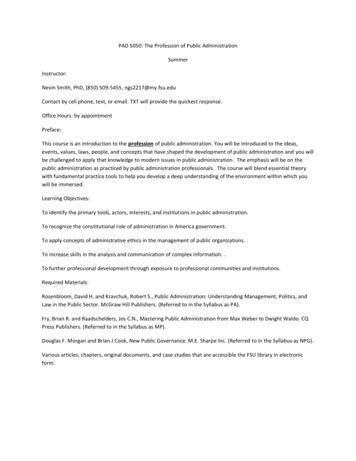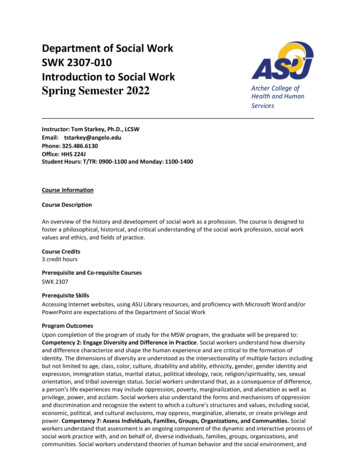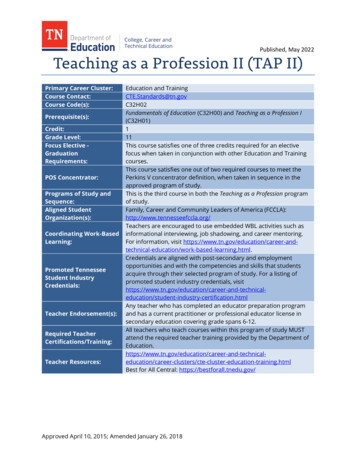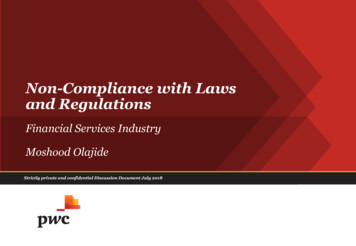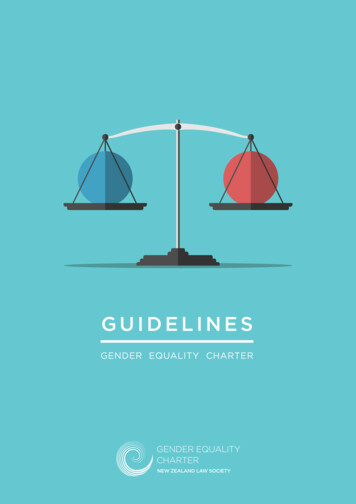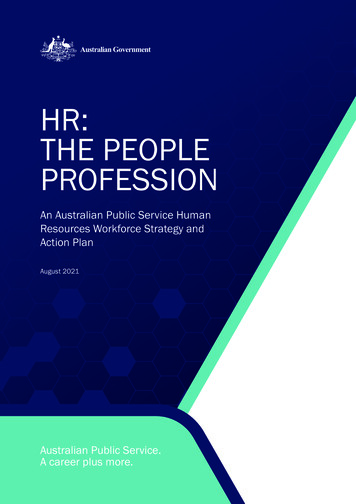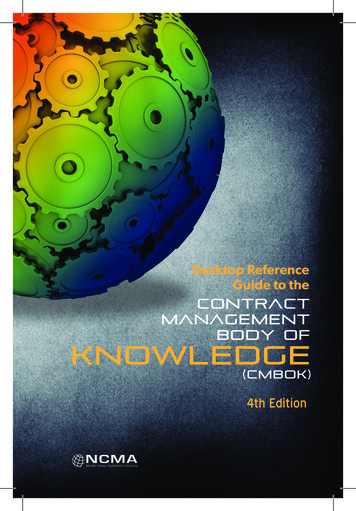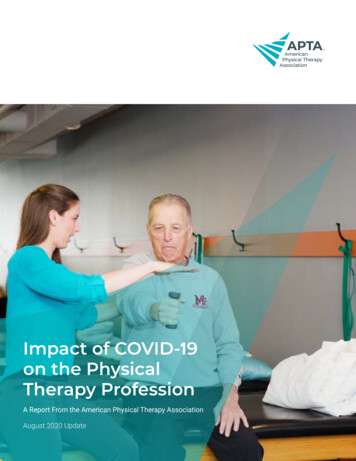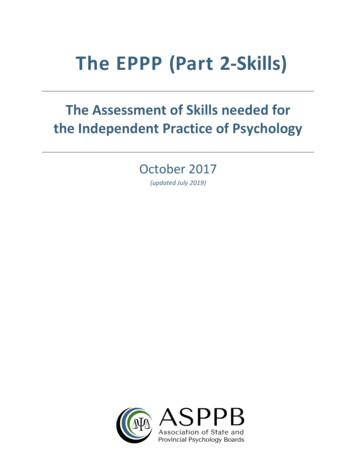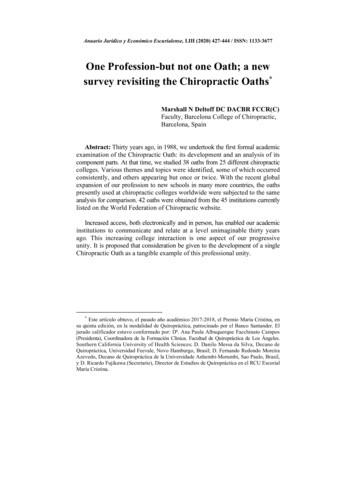
Transcription
Anuario Jurídico y Económico Escurialense, LIII (2020) 427-444 / ISSN: 1133-3677One Profession-but not one Oath; a newsurvey revisiting the Chiropractic Oaths*Marshall N Deltoff DC DACBR FCCR(C)Faculty, Barcelona College of Chiropractic,Barcelona, SpainAbstract: Thirty years ago, in 1988, we undertook the first formal academicexamination of the Chiropractic Oath: its development and an analysis of itscomponent parts. At that time, we studied 38 oaths from 25 different chiropracticcolleges. Various themes and topics were identified, some of which occurredconsistently, and others appearing but once or twice. With the recent globalexpansion of our profession to new schools in many more countries, the oathspresently used at chiropractic colleges worldwide were subjected to the sameanalysis for comparison. 42 oaths were obtained from the 45 institutions currentlylisted on the World Federation of Chiropractic website.Increased access, both electronically and in person, has enabled our academicinstitutions to communicate and relate at a level unimaginable thirty yearsago. This increasing college interaction is one aspect of our progressiveunity. It is proposed that consideration be given to the development of a singleChiropractic Oath as a tangible example of this professional unity.*Este artículo obtuvo, el pasado año académico 2017-2018, el Premio María Cristina, ensu quinta edición, en la modalidad de Quiropráctica, patrocinado por el Banco Santander. Eljurado calificador estuvo conformado por: Dª. Ana Paula Albuquerque Facchinato Campos(Presidenta), Coordinadora de la Formación Clínica. Facultad de Quiropráctica de Los Ángeles.Southern California University of Health Sciences; D. Danilo Messa da Silva, Decano deQuiropráctica, Universidad Feevale, Novo Hamburgo, Brasil; D. Fernando Redondo MoreiraAzevedo, Decano de Quiropráctica de la Universidade Anhembi-Morumbi, Sao Paulo, Brasil,y D. Ricardo Fujikawa (Secretario), Director de Estudios de Quiropráctica en el RCU EscorialMaría Cristina.
INTRODUCTIONThe chiropractic oath is more than a promise. It declares a code of ethicalbehaviour, subscribed to by the new graduate, that defines our profession. It is thefoundation of a social contract between the new doctor and patients, colleagues,other professionals and society in general. The commonalities and differencesuniquely chronicled in the chiropractic oaths reflect the historic and currentdiversity of the doctors that make up our great profession.METHODIn the initial 1988 study, each chiropractic college was asked to provide theauthors with a copy of its (then) current chiropractic oath, as well as any otheroaths the college had used in the past. In addition, it was requested that anysimilar information on colleges which have suspended operation be providedfrom library archives. Individual practitioners known to have been associatedwith colleges which were no longer operational were also contacted as potentialresources. Of the 23 existing colleges in 1988, only Japan College of Chiropracticdid not respond, providing a 96% response rate. In total, 38 oaths from 25chiropractic colleges were received for analysis.The number of schools has now grown to 45. This marked globalizationof chiropractic education is concurrent with a quantum leap in the ability tointeract, communicate and dialogue in ways barely imaginable 30 years ago.The existing schools were requested to provide a copy of their current chiropracticoath. All 45 schools responded, yielding a 100% response rate, and provided 42oaths for analysis. Again, as in 1988, all oaths received were utilized. The nonEnglish oaths were either accompanied by English translations provided by theschool, or were translated by native speakers or professional translators.The components of the oath were divided into categories: (1) G-d; (2) schoolname; (3) chiropractic terminology; (4) patient interaction; and (5) professionalattitude. Categories 3, 4 and 5 were then further subdivided into specific topicsAJEE, LIII (2020) 427-444/ISSN 1133-3677
430MARSHALL N DELTOFFappearing in the oaths. (Table 1) An additional subcategory was added for thiscurrent study: 4f: no discrimination. The frequency of these topics is shown inFigure 1 (comparing their frequency with the 1988 study). The specific topicsappearing in each individual oath are summarized in Table 2.Two of the oaths are not provided by the academic institutions. The oathrecited by UQTR graduates is administered, not by the school itself, but ratherby the profession’s regulatory body in Quebec, L’Ordre des Chiropraticiensdu Quebec. Similarly, it is the Chiropractic Association of South Africa thatadministers its oath to graduates of that country’s two chiropractic institutions.RESULTS/DISCUSSIONG-dPledging, swearing or affirming before G-d was a common componentback in 1988, appearing in 74% of submitted oaths in the original study. G-dwas referred to as “the Creator” in the Logan Basic College oath of 1939. Thirtyyears later, only 40% of oaths mention G-d. Is this huge decrease perhaps anindicator of a secularization of professional education, and, by extension, societyin general? The following schools had reference to G-d back in 1988, but havesince removed that reference: Anglo-European College, Life University andNew York College. Palmer College and Sherman College removed the referenceto G-d in 1978. Interestingly, Logan College, reversing the trend, added areference to G-d to its current oath in 1987. Western States College, to this day,still provides for an optional referral to G-d. Bahcesehir University graduatesspeak of “the architect of the universe”. Of note is a difference between theinclusion of G-d in the current oaths of US schools (65%) vs. non-US schools,at only 28%.School nameIn 1988, only Canadian Memorial and Western States actually mentioned theschool’s name in their oaths. Currently, 19% of the colleges mention the school'sname. Seven schools use the more generic “alma mater”; interestingly, all are inthe United States. Macquarie University grads mention only “my university”.Chiropractic terminologyAlthough the profession has always acknowledged chiropractic as an art,science and philosophy, by far ‘chiropractic art’ or ‘chiropractic healing art’AJEE, LIII (2020) 427-444/ISSN 1133-3677
ONE PROFESSION-BUT NOT ONE OATH; A NEW SURVEY REVISITING 431is the most consistently used in the chiropractic oaths; (82% in 1988, and 69%today). Science (39% in 1988 and 40% in 2018) and chiropractic philosophy(32% in1988 and 43% in 2018) were significantly less popular, although eachshowed an increase in the current study. Both the 1988 oath of Sherman Collegeof Straight Chiropractic and the current oath of New Zealand College refer to“enriching philosophical understanding” and “enhancing artistic ability “, whileomitting any mention of science.The use of ‘Natural laws’ was present in 37% of oaths in 1988 and in only 21%of today's oaths. The oath at Canadian Memorial College has always includedreference to the “Vis Medicatrix Naturae” Use of hands (11% in 1988; 5% in2018) and Innate (13% in 1988) were rare.‘Innate’ was actually only mentioned in the Canadian Memorial and WesternStates oaths in 1988. Today, only the oath of Canadian Memorial College stillcontains the word 'innate'. Sydney College (1988), and Macquarie University(2018) refer to “. the body’s inherent capacity for recovery”. BarcelonaCollege graduates (2018) mention “. inborn endowments”.The chiropractic concept of ‘dis-ease’ was only used by Canadian Memorialfrom 1945-54. The following year, the hyphen was dropped; the new collegeadministration that year likely brought on that change in the oath. ‘Vertebralsubluxation’ only appears twice; first, in the post-1978 oath of Sherman Collegeof Straight Chiropractic, remaining a part of the current oath of ShermanCollege, and second, in New Zealand College’s oath. Both state: “ honoredwith the opportunity to be instrumental in the correction of vertebralsubluxations”. (The only difference is the British spelling of ‘honoured’ inNew Zealand as a Commonwealth country).The ancient historic bond with medicine is represented by the use ofHippocrates’ name in the oaths of Barcelona College and Canadian MemorialCollege: “ . . . and with this torch of knowledge fashioned by Hippocrates, Iwill light the way to the understanding of those Natural Laws which preservethe human body as a fitting temple for the soul (of man) “.The oath of National College from 1935 until at least 1949 did not containany reference to 'chiropractic' at all, but rather mentioned “this drugless healingart”. National College did adopt the CCE oath in 1972, which did mention“ this chiropractic healing art “. However, today, National College graduatesonce more do not mention chiropractic in their oath, instead pledging tomaintain “ the honor and the noble traditions of the healing professions “. Thegraduates of Australia's oldest chiropractic school, Macquarie University,AJEE, LIII (2020) 427-444/ISSN 1133-3677
432MARSHALL N DELTOFF(formerly Sydney College), do not mention the word 'chiropractic' when theyrecite their oath. Additionally, the current oaths of Anglo-European College,McTimoney College, Universidad Estatal del Valle de Ecatepec and UniversidadEstatal del Valle de Toluca also have no reference to ‘chiropractic’; AngloEuropean College removed ‘chiropractic’ from its oath sometime after 1988.The Welsh Institute oath, used until 2017, also contained no reference tochiropractic, but rather used “ the art of healthcare ”.Patient interactionOf all components of the oath, the 'relief of suffering and of disease'appeared most often in the 1988 study at 87%. This certainly seems logical as itconstitutes the ultimate raison d'etre of our profession. Today, in a surprisingobservation, only 36% of oaths contain some reference to relief of sufferingand disease.'Keeping of a patient's confidence' is considered so important that it rankedsecond overall in frequency in 1988 (84%) and first overall in 2018 (78%).This phrase definitely alludes to our position of great responsibility; thatchiropractors are, in fact, professional confidants. The graduates of the nowdefunct Pasadena College would state “that I will not reveal to anyone anythingrevealed to me in the course of my work, save with full knowledge and permissionof the patient involved”. Sydney College (1959-90) merged with MacquarieUniversity in 1990, and all graduates, pre-and post-merger, pledged and continueto pledge to “ guard their secrets with scrupulous honour and fidelity”. Graduatesof the University of Central Chile promise to “save and respect professionalsecrecy”. Welsh Institute graduates, until 2017, would include “ respectingand protecting confidential information” as part of their oath.National College grads from at least 1935 through 1949 promised that“Whatever in connection with my professional practice, or not in connectionwith it, I may see or hear in the lives of men and women which ought not tobe spoken abroad, I will not divulge, reckoning that all such should be keptsecret “. Today, National grads today go so far as to say “I will respect the secretsthat are confided in me, even after the patient has died “.Hand in hand with keeping a patient's confidence is the promise to generally'refrain from wrongdoing’ (76% in 1988; 64% in 2018), also a very commontheme for a professional pledge, promise or oath.In the 1950’s graduates of the Chiropractic Institute of New York wouldpledge to “ abstain from all intentional mischief and harm “. Logan CollegeAJEE, LIII (2020) 427-444/ISSN 1133-3677
ONE PROFESSION-BUT NOT ONE OATH; A NEW SURVEY REVISITING 433graduates in the 1980’s promised that “I will not misrepresent myself or myprofession to others and will never use my knowledge of chiropractic to causeharm or injury to any person “.The graduates of Sydney College (and now Macquarie University) promiseto “ not engage in those practices which will in any way bring shame ordiscredit upon myself or my profession”. Current graduates at Southern CaliforniaUniversity pledge “to practice ethically and with honesty”. A number of oaths,both past and present, mention “to abstain from whatever is deleterious andmischievous” (CCE oath 1972, Texas College and University of Bridgeporttoday), or “to abstain from whatever is harmful or unethical” (NorthwesternUniversity since 1984). Palmer College and Palmer College-West grads currentlypromise to “ not violate that which is moral and right,” as did the graduates ofPennsylvania College of Straight Chiropractic. The graduates of the Frenchschool promise “to abstain from all intervention which may be dangerous ”.Welsh Institute graduates would promise to “ not abuse my professionalposition and at all times I will be honest and trustworthy”.‘Serving humanity’ (47% in 1988; 26% in 2018) is referred to in the oathshared by Palmer College and Palmer College-West, with the phrase “ help togrow in service to the benefit of all humanity”. Until sometime in the 1980’s,Cleveland College-KC grads would” champion the right of all humanityto enjoy the benefits and blessings of chiropractic “. National grads today puta somewhat different spin on serving humanity by stating “I will not use mymedical knowledge contrary to the laws of humanity, even under threat “.“To stand ready at all times to serve humanity” pledge current New YorkCollege and Northwestern University grads.Gender issues and sexism in the chiropractic oathOne of the more contentious topics considered here is the practice of onlyreferring to men in the oath. This circumstance was present overall in 68%of the oaths received in 1988 but only 26% of oaths used today. Refreshinglyahead of its time was the oath used at National College from 1935 until atleast 1949. While it did conclude with the commonly found 'respected by allmen at all times', it was the only oath which actually mentioned women.Canadian Memorial has changed its oath sometime between 1988 and today,by removing “of man” from the phrase “ fitting temple for the soul of man”,and by substituting “ stand ready to serve my fellow man” with “ stand readyto serve humanity”. Other colleges that no longer have sexist language includeAnglo-European College, New York College, Life College, Life College-West,AJEE, LIII (2020) 427-444/ISSN 1133-3677
434MARSHALL N DELTOFFLogan College, National College, Southern California University, Northwestern,Palmer (removed in 1978), and Western States (removed in 1982). ShermanCollege, the Danish schools, Lincoln College, Pasadena College, Sydney College/Macquarie University and Palmer College-West never had sexist language intheir oaths.Sexist language in a chiropractic oath should never have been acceptable,and it can be noted that steps have been taken by many of the colleges tocorrect their oaths over the past decades, demonstrating fairness, inclusion andrespect to the increasing number of women doctors.The 1972 oath adopted by the Council of Chiropractic Education used atthe convocation ceremonies at Los Angeles, National, New York, Parker andTexas Colleges back in 1988 contained sexist language. Additionally, the 1988oaths of Anglo-European, Canadian Memorial, Cleveland -KC, Cleveland-LA,Institut Francais, Life, Life-West, Logan, Phillip Institute and PennsylvaniaColleges also each contained at least one exclusively masculine reference.Although many of the oaths have definitely improved in this regard, today,the oaths of Bahcesehir University, Barcelona College, Cleveland College,Hanseo University, Institut Franco-Europeen, Madrid College (“ considermy colleagues as brothers “), Parker College, Texas College, UniversidadEstatal del Valle de Ecatepec, Universidad Estatal del Valle de Toluca andUniversidad Veracruzana still contain a reference to men only.For this current study, a new category was added to the oath analysis, thatof not discriminating against patients. This is a fairly popular concept in theoaths, appearing in 60%, and phrased in a variety of ways.The Welsh Institute and McTimoney College oaths include “I will neverdiscriminate unfairly against patients or colleagues”. Feevale Universitygraduates add simply “ without any form of discrimination”. “ withoutdistinction of race, creed or colour”, state the Canadian Memorial Collegeand D’Youville College graduates, as well as those at Anglo-EuropeanCollege, Northwestern University, Parker University, Texas College,University of Bridgeport, and grads from both South African schools.Southern California University’s oath changes the order to “race, color orcreed”. The Barcelona College oath has changed that to “ without distinctionof race, creed or beliefs”. The Madrid College graduates pledge to “Alwaysrespect political and religious beliefs, nationalities, races, and social andeconomic levels, ensuring that they avoid interfering between my professionalservices and my patients”. Sherman College graduates promise that “My bestservice will be available to all, regardless of their cultural, racial or religiousAJEE, LIII (2020) 427-444/ISSN 1133-3677
ONE PROFESSION-BUT NOT ONE OATH; A NEW SURVEY REVISITING 435background, or their ability to pay”. The first graduates of the Keiser Universityprogram, scheduled to graduate next within the year, will include in theiroath “I will respect without regard to gender, race, national origin, religionor sexual orientation”. National University has the most inclusive list in itsoath, stating “I will not permit considerations of age, disease or disability, creed,ethnic origin, gender, nationality, political affiliation, race, sexual orientation,social standing or any other factor to intervene between my duty and mypatient”. Institut Francais graduates promise to “ provide bountiful help atall times to my neighbour, without distinction of race or belief”. The NewZealand College oath states “My best service will be available to all, regardlessof their cultural, racial or religious background, or their ability to pay”.Professional attitudeForty-two percent of all oaths in the 1988 study mentioned having a 'positiveregard for colleagues' while today the percentage has risen to 48%. This addressesthe issue of respecting other chiropractors and promoting professional unityand harmony. This is perhaps most explicitly stated in the 1986 Logan Collegeoath: “I will not denigrate those in my profession who choose to use methodsdifferent from mine”. National College grads today maintain that “my colleagueswill be my sisters and brothers”. Murdoch University grads state that “I willregard my fellow health professionals with courtesy and good faith”. A MacquarieUniversity graduate promises that “I will endeavor to work in accord withmy colleagues in a spirit of progressive cooperation and never by word or actcast imputations upon them or their rightful practices”.Respect for teachers, commonly referred to as 'those who taught me thischiropractic healing art', was a moderately popular inclusion in the 1988 study(53%), and reduced today to 38%. While the oath is a professional promise,it is recited as a final act within the academic environment, and thus, respectfor teachers ties in well with the transition from student to practitioner. TheInstitut Franco-Europeen graduates pledge to “always respect the pioneers ofthe chiropractic art, and those who taught it to me”.With the understanding that every graduate is, in effect, an eternalstudent, several of the oaths (34% in 1988 which has increased to 60% today)include phrases in which the graduate pledges to 'keep an open mind', 'continueto learn' and 'improve his/her knowledge'. These include: “I will keep an openmind regarding the progress of my profession.” (Columbia Institute 1966,Life College, Life College West, Logan College 1987 , Palmer College, ShermanCollege 1973-78); “I shall keep abreast of the advancements in my profession”(Lincoln College); “I will actively continue to learn and to improve my skills”AJEE, LIII (2020) 427-444/ISSN 1133-3677
436MARSHALL N DELTOFF(Logan College 1986); I will keep an open mind regarding the changes in myprofession. “(Pennsylvania College) and “I pledge to. constantly maintainmy knowledge” (Institut Franco-Europeen). McTimoney College graduateshumbly admit that “Recognizing the limits of my competence, I will keepmy professional skills and knowledge up to date”. A New York Collegegraduate pledges that “through lifelong learning I will keep my skills andmind sharp”. At Western States University, grads promise that “I willcontinue learning throughout my life so that I may provide for the good ofmy patients”. The graduates of Murdoch University pledge that “I willcontinually and judiciously improve my knowledge and skill”. Welsh Institutegraduates, until administration of their oath ceased in 2017, would pledge“ will look to contemporary science and evidence for what I do ”.Improving knowledge and skill is an important component of the promisemade by a chiropractor at graduation. Any proposed universally acceptedchiropractic oath should include a phrase to that effect. Even as early as1948, Palmer College had the foresight to comment on advancement in theprofession as part of its oath. It is the graduates' responsibility to their patients toremain contemporary in academic and clinical knowledge in order to best servethem. Thus, 'improving knowledge' would seem to be a proper inclusion inthe graduation pledge.The Chiropractic Institute of New York oaths (1956-1960) even mention“to impart, unreservedly, instruction in the Art and Science of Chiropracticto my colleagues, but to none others”. This unique phrase ties in the idea ofcooperation and regard for colleagues with the concept chiropractors canteach each other as well as learn from each other.More than half of the oaths in the original study (55%) mention 'living upto the principles' of the profession. This figure has gone down to 48% today.There is a variety of ways in which this is stated: “. insofar as my science is inthe highest precepts of my alma mater and harmonious with the Vis MedicatrixNaturae” (Canadian Memorial College); “To live up to the highest principlesof my profession” (Cleveland-KC 1980 ). “To always live up to the highprinciples of my profession (Cleveland-KC pre-1956, Cleveland-LA 1950 ).“I will observe and practice every acknowledged rule of professional conduct inrelation to my profession, my patient, my colleague and myself “ (BahcesehirUniversity -present, Columbia Institute 1966, Durban University of Technology-present, Hanseo University -present, International Medical University -present,Life College, Life College-West, Logan University 1987-present, MurdochUniversity -present, Pennsylvania College 1977-1995, Sherman College 19731978, University of Johannesburg -present, Universidad Veracruzana-present).AJEE, LIII (2020) 427-444/ISSN 1133-3677
ONE PROFESSION-BUT NOT ONE OATH; A NEW SURVEY REVISITING 437“To hold my profession and the practice of my profession to the height forwhich its value provides” (Logan Basic College 1939); “I will strive to bringcredit to. my profession” (Logan College 1986); “I will adhere to the code ofethics espoused by the chiropractic profession” (Palmer College 1983-present,Palmer College-West post 1988). “That I will adhere faithfully to the principlesand practice of Chiropractic Art and teachings” (Pasadena College 1974-1995).'Protecting chiropractic' is a topic found in 13% of oaths in 1988; this hasincreased to 17% in 2018. The oaths of Columbia Institute diplomaticallystated, “I will scrupulously maintain the dignity and honor of my profession atall times. “Palmer College graduates (1983 ) now say, “I will seek to preservethe integrity of my profession. “Each Cleveland College-KC graduate (pre1957) defiantly pledged “to protect my science from all enemies”. From1950 until the school closed in 2011, every Cleveland College-LA graduatepromised to “protect my science”; this phrase is still recited today by ClevelandCollege-KC grads. Graduates of the University of Central Chile state” tokeep unharmed, by all means at my disposal, the honor and noble traditionsof the Chiropractic profession”. “I will do anything within the law to protectthe rights of chiropractic as an autonomous profession “declare the graduatesof Turkey’s chiropractic school. National College graduates state” will maintainby all means in my power, the honor and the noble traditions of the healingprofessions “, oddly not specifically mentioning chiropractic.'Referral of patients' is mentioned in only 5% of the oaths in the 1988study. This topic reminds graduates of the limitations of chiropractic. In thecurrent study, the percentage has more than doubled to 11%. Perhaps this reflectsa lessening of the historic animosity between chiropractic and medicine, withgreater interprofessional dialogue and cooperation. A new Lincoln Collegedoctor would promise “that I shall call consultants for all cases where suchconsultation will benefit the patient. That I shall not hesitate to refer patientsto practitioners of other professions if in my opinion such advice will benefitthose patients”. The Chiropractic Institute of New York oath, with regard tomedical referral, goes so far as to state, “I will not use the knife, but will giveplace to craftsmen in the use thereof “. The McTimoney College oath statesthat graduates” will work with colleagues in the ways that best servepatients”. Bahcesehir University grads say that “I will make use of all alliedhealth care providers and refer my patient if the referral shall serve to thebest interest of the patient “. Western States University graduates promisethat “I will collaborate with other health care professionals to promote publichealth and wellness “. The Welsh Institute oath alluded to referral with “Iwill do what is best for my patients, and in this recognize my own limits ofcompetence and scope, as well as the expertise of others “.AJEE, LIII (2020) 427-444/ISSN 1133-3677
438MARSHALL N DELTOFF'Financial gain' is a component only of the Pasadena College oath in the1988 paper; this is a rather peculiar topic for an oath to contain. It is specificallyonly mentioned once: “. I shall be rewarded with respect and financial reality “,and is alluded to earlier on in the oath: “. and will share with them the rewardswhich may come to me. “While 'financial reality' is one of the rewards forthe hard-working, ethical practitioner, its inclusion in a professional oath maytarnish and detract from the altruistic spirit which makes it so special.'Involvement in professional associations and/or the community’ certainlyallows the graduate to contribute and grow as a person and a professional.Both involve a degree of goodwill, commitment and selflessness. MacquarieUniversity’s oath states, “I will be ever vigilant in aiding the general welfare ofthe community, sustaining its laws and institutions “. It is the only existing oathwhich mentions contributing to the welfare of the community; it’s been aphrase in its oath from back in the Sydney College era.Additional observationsInterestingly and unfortunately, there are several institutions that do notcurrently administer a chiropractic oath at all. The chiropractic school at theUniversity of Zurich, reported that “there is no special oath for the chiropracticstudents. They swear the regular human medicine oath “. (Manuela Lüber,Department Assistant and Deputy Head of Administration, School of ChiropracticMedicine, University of Zurich, personal communication, January 11, 2018).The Swedish College of Chiropractic (Skandinaviska Kiropraktorhogskolan)informed the author that “We don’t have those kind of ceremonies in Swedenoverall, and therefore not in our school either “. (Mikael Jansson, SkandinaviskaKiropraktorhogskolan, personal communication, October 18, 2018).Brisbane’s Central Queensland University has graduated two classes ofchiropractors, and, according to Dr. Andrew Dane, Lecturer, School of Health,Medical and Applied Sciences, Central Queensland University, their students donot swear an oath either in clinic or at graduation (personal communication,November 16, 2018).Dr. Michael Haneline, Director of the Center for Complementary andAlternative Medicine at International Medical University (IMU) in KualaLumpur, reported that “The University does not have an oath that is specificfor the chiropractic program” (personal communication, October 22, 2018).The president of the Malaysian Association of Chiropractic, Dr. Wong Yi Kai,explained that the chiropractic graduates of IMU were using the HippocraticAJEE, LIII (2020) 427-444/ISSN 1133-3677
ONE PROFESSION-BUT NOT ONE OATH; A NEW SURVEY REVISITING 439oath upon enrollment in the chiropractic program, so the Association submitteda version of the chiropractic oath (used in this study) to the school. The oathwas used only for the first two graduating classes, and then abandoned as “theIMU graduates of the second class do not see value in it” (personal communication,October 21, 2018).The Welsh Institute of Chiropractic used a chiropractic oath at graduationceremonies up until 2017. “The university decided to drop it; there are reasonsfor this and we are currently looking at alternatives “, explained Dr. DavidByfield, Head of Clinical Services at the Welsh Institute (personal communication,October 25, 2018). He noted that Anglo-European College worked on theoath for the Welsh Institute. This oath was used in the current study.Several chiropractic colleges have either never changed their oath or onlyminimally changed it. The original Danish Chiropractors’ School, the firstchiropractic college outside of North America, operated from 1948-51, andgraduated only one class, on June 4, 1951. Its oath, with one minor modification(“practicing chiropractor” replaced with “my business as a
Of the 23 existing colleges in 1988, only Japan College of Chiropractic did not respond, providing a 96% response rate. In total, 38 oaths from 25 chiropractic colleges were received for analysis. The number of schools has now grown to 45. This marked globalization of chiropractic education is concurrent with a quantum leap in the ability to
